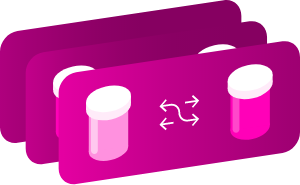Identification
- 总结
-
Odesivimabis part of a product containing three monoclonal IgG1κ antibodies directed against the GP1,2 glycoprotein of Zaire ebolavirus. Together, these three antibodies act to neutralize viral particles and to recruit immune effectors for the destruction of both viral particles and infected cells.
- Brand Names
-
Inmazeb
- Generic Name
- Odesivimab
- DrugBank一ccession Number
- DB15900
- Background
-
Ebola virus (EBOV) remains an important human pathogen within theEbolavirusgenus, having been responsible for at least 17 known outbreaks with an average case fatality rate of 43.92%.1Immune therapy using monoclonal antibodies (mAbs) is becoming an increasingly attractive therapeutic method to combat infectious diseases due to its rapid development, low toxicity, and high specificity.3The chief surface target of EBOV particles is the GP1,2glycoprotein, which also appears on the surface of EBOV-infected cells, offering opportunities for both neutralizing and cytotoxic (i.e. through Fc-mediated immune effector function) antibody effects to play a role in combatting EBOV infection.1,2A recent large-scale study elucidated that both neutralizing and Fc-mediated functions of antibodies were important for therapeutic benefit in animal models of EBOV infection.3
INMAZEB™, formerly referred to as REGN-EB3, combines the three humanized IgG1κ mAbs Odesivimab (REGN 3471),Maftivimab(REGN 3479), andAtoltivimab(REGN 3470) in equimolar proportions. All three mAbs bind to a distinct portion of the GP1,2glycoprotein and collectively provide neutralizing and Fc-mediated immune effector function against EBOVin vitroand protection against EBOV infectionin vivo. INMAZEB™ is produced by Regeneron Pharmaceuticals and was granted FDA approval on October 14, 2020.4
- Type
- Biotech
- Groups
- Approved
- Biologic Classification
-
Protein Based Therapies
Monoclonal antibody (mAb) - Protein Chemical Formula
- C6506H10024N1720O2030S42
- 蛋白质平均体重
- 146164.54 Da (Polypeptide only)
- Sequences
- Not Available
- Synonyms
-
- Odesivimab
- odesivimab-ebgn
- External IDs
-
- REGN-3471
- REGN3471
- WHO 11033
Pharmacology
- Indication
-
Odesivimab is indicated in combination withMaftivimabandAtoltivimabfor the treatment ofZaire ebolavirusinfection in adult and pediatric patients, including neonates born to a mother who has been confirmed positive by RT-PCR forZaire ebolavirusinfection. This combination has not been established as efficacious for any other species within either theEbolavirusorMarburgvirusgenera; special care should be taken to evaluate the susceptibility of circulatingZaire ebolavirusstrains before beginning treatment, and the possible emergence of resistance should be monitored.4
 Reduce drug development failure ratesBuild, train, & validate machine-learning models
Reduce drug development failure ratesBuild, train, & validate machine-learning models
with evidence-based and structured datasets.Build, train, & validate predictive machine-learning models with structured datasets. - Associated Conditions
- Contraindications & Blackbox Warnings
-
 Avoid life-threatening adverse drug eventsImprove clinical decision support with information oncontraindications & blackbox warnings, population restrictions, harmful risks, & more.Avoid life-threatening adverse drug events & improve clinical decision support.
Avoid life-threatening adverse drug eventsImprove clinical decision support with information oncontraindications & blackbox warnings, population restrictions, harmful risks, & more.Avoid life-threatening adverse drug events & improve clinical decision support. - Pharmacodynamics
-
Odesivimab is a fully-humanized IgG1κ monoclonal antibody (mAb) directed against the GP1,2glycoprotein that provides both neutralizing and Fc-dependent immune-mediated activity againstZaire ebolavirus. As a mAb, Odesivimab exhibits low toxicity and is generally well tolerated but does include the risk of potentially life-threatening hypersensitivity reactions.4
- Mechanism of action
-
Ebola virus (EBOV) is one of several viruses within theEbolavirusgenus known to infect humans with an average case fatality rate of 43.92%.1EBOV particles expose the GP1,2glycoprotein on their surface, which comprises a trimer of GP1and GP2subunit heterodimers, with the subunits connected by a disulfide bond. GP1,2plays an important role in both cell surface attachment/entry and eventual lysosomal escape through binding to the NPC intracellular cholesterol transporter 1/Niemann-Pick C1 protein (NPC1). In this manner, GP1,2is integral to the pathogenic cycle of EBOV.1,2
Odesivimab is a fully-humanized IgG1κ monoclonal antibody (mAb) directed against the EBOV GP1,2glycoprotein, which binds within the "chalice" structure near the GP head in partial contact with the glycan cap with a binding affinity (KD) of between 8.26 and 8.42 nM.2,4Odesivimab exhibits weak (<50%) neutralization of chimeric lentiviral particles expressing EBOV GP1,2and is able to bind soluble GP1,2. In addition, Odesivimab is capable of dose-dependent activation of FcγRIIIa signalling in effector cells in the presence of GP1,2-expressing cells with a half-maximal effective concentration (EC50) of 1.6 nM.2Combined withMaftivimabandAtoltivimab, Odesivimab works to block EBOV cell infection and lysosomal escape, as well as the potential antibody-dependent cell-mediated killing of EBOV-infected cells.1,2,3,4
Target Actions Organism AEnvelope glycoprotein antagonistZaire ebolavirus (strain Mayinga-76) - Absorption
-
Odesivimab administered to healthy subjects at 50 mg/kg produced a mean Cmaxof 1260 ± 81.2 mg/L and a mean AUC0-∞of 25,600 ± 5040 mg*day/L.4
- Volume of distribution
-
Odesivimab administered to healthy subjects at 50 mg/kg produced a mean steady-state volume of distribution of 56.0 ± 3.16 mL/kg.4
- Protein binding
-
Not Available
- Metabolism
- Not Available
- Route of elimination
-
Not Available
- Half-life
-
Odesivimab administered to healthy subjects at 50 mg/kg has a mean elimination half-life of 25.3 ± 3.86 days.4
- Clearance
-
Odesivimab administered to healthy subjects at 50 mg/kg has a mean clearance of 2.02 ± 0.374 mL/day/kg.4
- Adverse Effects
-
 Improve decision support & research outcomesWith structured adverse effects data, including:blackbox warnings, adverse reactions, warning & precautions, & incidence rates.Improve decision support & research outcomes with our structured adverse effects data.
Improve decision support & research outcomesWith structured adverse effects data, including:blackbox warnings, adverse reactions, warning & precautions, & incidence rates.Improve decision support & research outcomes with our structured adverse effects data. - Toxicity
-
Not Available
- Pathways
- Not Available
- Pharmacogenomic Effects/ADRsBrowse all" title="" id="snp-actions-info" class="drug-info-popup" href="javascript:void(0);">
- Not Available
Interactions
- Drug InteractionsLearn More" title="" id="structured-interactions-info" class="drug-info-popup" href="javascript:void(0);">
-
This information should not be interpreted without the help of a healthcare provider. If you believe you are experiencing an interaction, contact a healthcare provider immediately. The absence of an interaction does not necessarily mean no interactions exist.
Drug Interaction Integrate drug-drug
interactions in your softwareAbciximab The risk or severity of adverse effects can be increased when Abciximab is combined with Odesivimab. Adalimumab The risk or severity of adverse effects can be increased when Adalimumab is combined with Odesivimab. Adenovirus type 7 vaccine live The therapeutic efficacy of Adenovirus type 7 vaccine live can be decreased when used in combination with Odesivimab. Aducanumab The risk or severity of adverse effects can be increased when Aducanumab is combined with Odesivimab. Alemtuzumab The risk or severity of adverse effects can be increased when Alemtuzumab is combined with Odesivimab. Alirocumab The risk or severity of adverse effects can be increased when Alirocumab is combined with Odesivimab. Amivantamab The risk or severity of adverse effects can be increased when Odesivimab is combined with Amivantamab. Anifrolumab The risk or severity of adverse effects can be increased when Anifrolumab is combined with Odesivimab. Ansuvimab The risk or severity of adverse effects can be increased when Odesivimab is combined with Ansuvimab. 炭疽人类免疫球蛋白 The risk or severity of adverse effects can be increased when Anthrax immune globulin human is combined with Odesivimab.  Identify potential medication risksEasily compare up to 40 drugs with our drug interaction checker.Get severity rating, description, and management advice.Learn more
Identify potential medication risksEasily compare up to 40 drugs with our drug interaction checker.Get severity rating, description, and management advice.Learn more - Food Interactions
- No interactions found.
产品
-
 Drug product information from 10+ global regionsOur datasets provide approved product information including:
Drug product information from 10+ global regionsOur datasets provide approved product information including:
做sage, form, labeller, route of administration, and marketing period.Access drug product information from over 10 global regions. - Mixture Products
-
Name 成分 Dosage Route Labeller Marketing Start Marketing End Region Image Inmazeb Odesivimab(241.7 mg/14.5mL)+Atoltivimab(241.7 mg/14.5mL)+Maftivimab(241.7 mg/14.5mL) Injection, solution Intravenous Regeneron Pharmaceuticals, Inc. 2020-10-14 Not applicable US Inmazeb Odesivimab(483.3 mg/14.5mL)+Atoltivimab(483.3 mg/14.5mL)+Maftivimab(483.3 mg/14.5mL) Injection, solution Intravenous Regeneron Pharmaceuticals, Inc. 2021-07-29 Not applicable US
Categories
- Drug Categories
- Chemical TaxonomyProvided byClassyfire
-
- Description
- Not Available
- Kingdom
- Organic Compounds
- Super Class
- Organic Acids
- Class
- Carboxylic Acids and Derivatives
- Sub Class
- Amino Acids, Peptides, and Analogues
- Direct Parent
- Peptides
- Alternative Parents
- Not Available
- Substituents
- Not Available
- Molecular Framework
- Not Available
- External Descriptors
- Not Available
- Affected organisms
-
- Zaire ebolavirus (strain Mayinga-76)
Chemical Identifiers
- UNII
- UY9LQ8P6HW
- CAS number
- 2135632-30-1
References
- Synthesis Reference
-
Pascal KE, Dudgeon D, Trefry JC, Anantpadma M, Sakurai Y, Murin CD, Turner HL, Fairhurst J, Torres M, Rafique A, Yan Y, Badithe A, Yu K, Potocky T, Bixler SL, Chance TB, Pratt WD, Rossi FD, Shamblin JD, Wollen SE, Zelko JM, Carrion R Jr, Worwa G, Staples HM, Burakov D, Babb R, Chen G, Martin J, Huang TT, Erlandson K, Willis MS, Armstrong K, Dreier TM, Ward AB, Davey RA, Pitt MLM, Lipsich L, Mason P, Olson W, Stahl N, Kyratsous CA: Development of Clinical-Stage Human Monoclonal Antibodies That Treat Advanced Ebola Virus Disease in Nonhuman Primates. J Infect Dis. 2018 Nov 22;218(suppl_5):S612-S626. doi: 10.1093/infdis/jiy285.
- 通用再保险公司ferences
-
- Jacob ST, Crozier I, Fischer WA 2nd, Hewlett A, Kraft CS, Vega MA, Soka MJ, Wahl V, Griffiths A, Bollinger L, Kuhn JH: Ebola virus disease. Nat Rev Dis Primers. 2020 Feb 20;6(1):13. doi: 10.1038/s41572-020-0147-3. [Article]
- Pascal KE, Dudgeon D, Trefry JC, Anantpadma M, Sakurai Y, Murin CD, Turner HL, Fairhurst J, Torres M, Rafique A, Yan Y, Badithe A, Yu K, Potocky T, Bixler SL, Chance TB, Pratt WD, Rossi FD, Shamblin JD, Wollen SE, Zelko JM, Carrion R Jr, Worwa G, Staples HM, Burakov D, Babb R, Chen G, Martin J, Huang TT, Erlandson K, Willis MS, Armstrong K, Dreier TM, Ward AB, Davey RA, Pitt MLM, Lipsich L, Mason P, Olson W, Stahl N, Kyratsous CA: Development of Clinical-Stage Human Monoclonal Antibodies That Treat Advanced Ebola Virus Disease in Nonhuman Primates. J Infect Dis. 2018 Nov 22;218(suppl_5):S612-S626. doi: 10.1093/infdis/jiy285. [Article]
- Saphire EO, Schendel SL, Gunn BM, Milligan JC, Alter G: Antibody-mediated protection against Ebola virus. Nat Immunol. 2018 Nov;19(11):1169-1178. doi: 10.1038/s41590-018-0233-9. Epub 2018 Oct 17. [Article]
- FDA Approved Drug Products: INMAZEB (atoltivimab, maftivimab, and odesivimab-ebgn) injection [Link]
- External Links
-
- 2461434
- Wikipedia
- Odesivimab
Clinical Trials
- Clinical TrialsLearn More" title="" id="clinical-trials-info" class="drug-info-popup" href="javascript:void(0);">
-
Phase Status Purpose Conditions Count 2 Not Yet Recruiting Prevention Ebolavirus Disease 1 Not Available Available Not Available Ebolavirus Disease 1
Pharmacoeconomics
- Manufacturers
-
Not Available
- Packagers
-
Not Available
- Dosage Forms
-
Form Route Strength Injection, solution Intravenous - Prices
- Not Available
- Patents
- Not Available
Properties
- State
- Liquid
- Experimental Properties
- Not Available
Targets

insights and accelerate drug research.
- Kind
- Protein
- Organism
- Zaire ebolavirus (strain Mayinga-76)
- Pharmacological action
-
Yes
- Actions
-
Antagonist
- Curator comments
- Odesivimab is a fully-humanized IgG1κ monoclonal antibody (mAb) directed against the EBOV GP1,2glycoprotein, which binds within the "chalice" structure near the GP head in partial contact with the glycan cap with a binding affinity (KD) of between 8.26 and 8.42 nM.[A221830, L17320]
- General Function
- Envelope glycoprotein Trimeric GP1,2 complexes form the virion surface spikes and mediate the viral entry processes, with GP1 acting as the receptor-binding subunit and GP2 as the membrane fusion subunit. At later times of infection, downregulates the expression of various host cell surface molecules that are essential for immune surveillance and cell adhesion. Down-modulates several integrins including ITGA1, ITGA2, ITGA3, ITGA4, ITGA5, ITGA6, ITGAV and ITGB1. This decrease in cell adhesion molecules may lead to cell detachment, contributing to the disruption of blood vessel integrity and hemorrhages developed during infection (cytotoxicity). Interacts with host TLR4 and thereby stimulates the differentiation and activation of monocytes leading to bystander death of T-lymphocytes (PubMed:28542576). Downregulates as well the function of host natural killer cells (PubMed:30013549). Counteracts the antiviral effect of host BST2/tetherin that restricts release of progeny virions from infected cells. However, cooperates with VP40 and host BST2 to activate canonical NF-kappa-B pathway in a manner dependent on neddylation.
- Specific Function
- Identical protein binding
- Gene Name
- GP
- Uniprot ID
- Q05320
- Uniprot Name
- Envelope glycoprotein
- 分子量
- 74463.855 Da
References
- Pascal KE, Dudgeon D, Trefry JC, Anantpadma M, Sakurai Y, Murin CD, Turner HL, Fairhurst J, Torres M, Rafique A, Yan Y, Badithe A, Yu K, Potocky T, Bixler SL, Chance TB, Pratt WD, Rossi FD, Shamblin JD, Wollen SE, Zelko JM, Carrion R Jr, Worwa G, Staples HM, Burakov D, Babb R, Chen G, Martin J, Huang TT, Erlandson K, Willis MS, Armstrong K, Dreier TM, Ward AB, Davey RA, Pitt MLM, Lipsich L, Mason P, Olson W, Stahl N, Kyratsous CA: Development of Clinical-Stage Human Monoclonal Antibodies That Treat Advanced Ebola Virus Disease in Nonhuman Primates. J Infect Dis. 2018 Nov 22;218(suppl_5):S612-S626. doi: 10.1093/infdis/jiy285. [Article]
- FDA Approved Drug Products: INMAZEB (atoltivimab, maftivimab, and odesivimab-ebgn) injection [Link]
Drug created at October 16, 2020 15:19 / Updated at January 27, 2022 21:15




